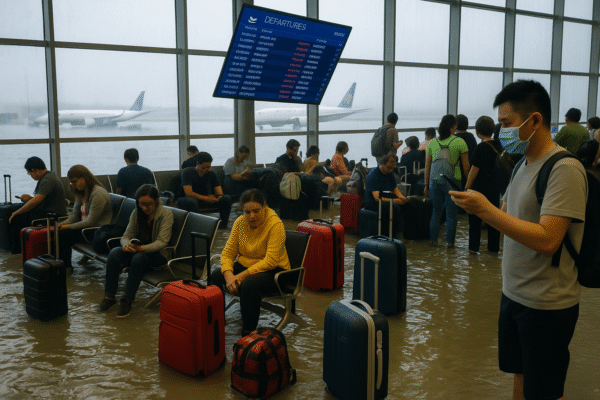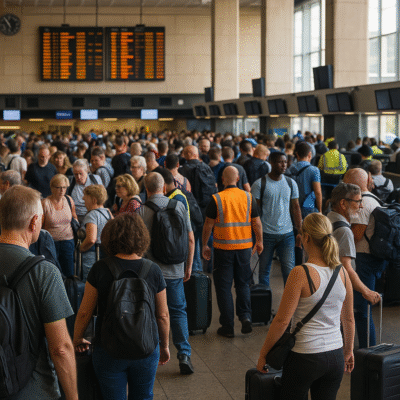Air Traffic System Failure at Johannesburg’s OR Tambo International Airport Causes Widespread Travel Disruptions
Johannesburg, South Africa — An unexpected technical failure in the air traffic control systems at OR Tambo International Airport brought operations to a standstill earlier this week, causing widespread delays, flight cancellations, and travel headaches for passengers across the globe.
The incident unfolded on Monday morning when a radar malfunction within the air traffic management system forced Air Traffic and Navigation Services (ATNS) to halt flight departures and delay inbound arrivals. Though resolved within a few hours, the disruption had a ripple effect throughout the day, affecting connecting flights and regional schedules throughout Southern Africa.
What Caused the Disruption at OR Tambo Airport?
In an official statement, ATNS confirmed that the problem stemmed from a technical glitch in radar data processing and display systems, which are critical for ensuring real-time aircraft surveillance and communications. The system failure made it temporarily impossible for air traffic controllers to track aircraft or guide them through Johannesburg’s busy airspace safely.
“Controllers initiated contingency protocols, including ground stops and limited rerouting of air traffic,” said ATNS. These measures, while necessary for passenger safety, significantly delayed both domestic and international flight schedules.
Extent of the Disruption: Delays, Missed Flights, and Ground Stops
The fallout from the radar failure was immediate and far-reaching. OR Tambo International Airport, the continent’s busiest and South Africa’s flagship aviation hub, saw the following impacts:
- Ground stops for outgoing flights
- Holding patterns implemented for incoming international aircraft
- Diversions to nearby airports in extreme cases
- Missed connections, particularly for passengers traveling to and from Asia, Europe, and the Americas
- Increased demand for airport accommodation and alternative transit options
While flights gradually resumed as technicians restored the system, passengers faced hours-long delays. Airlines worked to rebook affected travelers and offered meal vouchers and accommodation where applicable.
Impact on Tourism and Travel Industry
As one of the primary gateways to Africa, OR Tambo International Airport plays a vital role in regional tourism, international business travel, and logistics. Travel analysts emphasize that even brief outages at such major hubs can have cascading effects across multiple continents.
Tour operators reported a rise in rescheduling requests, while travel insurance providers noted increased inquiries about compensation and travel delay claims. Car rental services and rideshare platforms also saw a spike in demand, as stranded passengers looked for overnight lodging or alternative ways to reach their destinations.
Aviation Experts Call for Infrastructure Upgrades
This incident has reignited conversations around aviation infrastructure resilience in South Africa. According to the South African Department of Transport, plans are underway to upgrade ATNS systems and invest in radar redundancy, backup power, and enhanced air traffic controller training.
“With OR Tambo serving as a major connector for Southern Africa, these upgrades are no longer optional—they are critical for our economy and global perception,” said a representative from the South African Civil Aviation Authority (SACAA).
In recent years, the airport has been undergoing several modernization initiatives, including the expansion of its international terminal and upgrades to its baggage handling systems. This latest radar system issue adds urgency to the agenda for enhanced digital resilience.
Local Economic Implications and Response
Johannesburg’s hospitality sector witnessed a temporary boost as delayed travelers booked last-minute hotel rooms and dining options. The Johannesburg Tourism Company, a key body under the City of Johannesburg, reassured visitors that support was being provided at the airport, including tourism desks and multilingual staff to assist travelers with changes.
“While this event was disruptive, it highlighted the strength of Johannesburg’s service infrastructure and the cooperation between airlines, government agencies, and private operators,” said a spokesperson.
Back to Normal: What Travelers Should Know
By late afternoon, flight operations had returned to normal, with air traffic controllers clearing the backlog of grounded or rerouted flights. Airlines advised travelers to reconfirm flight status before heading to the airport and to allow extra time for security and check-in formalities.
Travelers are also encouraged to enroll in flight alert systems and consider travel insurance that covers operational delays—a common recommendation for anyone flying through high-traffic international airports like OR Tambo.
Looking Ahead: Lessons and Safeguards
While the failure caused significant inconvenience, it served as a powerful reminder of the complex, technology-driven nature of modern air travel. From radar systems and GPS navigation to air-to-ground communication networks, a single point of failure can disrupt thousands of journeys.
However, authorities acted swiftly, and normal operations resumed faster than expected, minimizing longer-term impacts. This event has accelerated efforts to future-proof air traffic systems not only in Johannesburg but across other African airports that rely on OR Tambo as a central hub.
For more travel news like this, keep reading Global Travel Wire





















